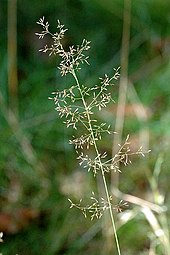| Agrostis canina | |
|---|---|

| |
| Conservation status | |
 Least Concern (IUCN 3.1) | |
| Scientific classification | |
| Kingdom: | Plantae |
| Clade: | Tracheophytes |
| Clade: | Angiosperms |
| Clade: | Monocots |
| Clade: | Commelinids |
| Order: | Poales |
| Family: | Poaceae |
| Subfamily: | Pooideae |
| Genus: | Agrostis |
| Species: | A. canina |
| Binomial name | |
| Agrostis canina L. | |
Agrostis canina, the velvety bentgrass, brown bent or velvet bent, is a species of grass in the family Poaceae.
Description

Agrostis canina is a perennial plant, with stolons but no rhizomes, and culms which grow to a height of up to 75 centimetres (30 in). It is frequently confused with Agrostis vinealis (formerly treated as a subspecies or variety of A. canina), which grows in more upland habitats and has rhizomes rather than stolons.
The leaf blades are 2–15 cm (0.8–5.9 in) long and 1–3 mm (0.04–0.12 in) wide, with an acute or acuminate ligule up to 4 mm (0.16 in) long.
The plant flowers from May to July, and the inflorescence is a panicle 3–16 cm (1.2–6.3 in) long and up to 7 cm (2.8 in) wide, with rough branches. Each spikelet is 1.9–2.5 mm (0.07–0.10 in) long; the lemma is 1.6 mm (0.063 in) long with an awn attached around the middle.
Distribution and ecology
The range of Agrostis canina covers most of Europe and temperate parts of Asia, and extends from sea level to the alpine zone. It has also been introduced to eastern North America, Hawaiʻi, Algeria and the Kerguelen Islands.
Agrostis canina is sensitive to drought, but is common in damp places, including ditches and lake margins.
The short, green growth of A. canina has made it popular as a lawn grass.
References
- ^ Lansdown, R.V. (2014). "Agrostis canina". IUCN Red List of Threatened Species. 2014: e.T167861A42382326. doi:10.2305/IUCN.UK.2014-1.RLTS.T167861A42382326.en. Retrieved 20 November 2021.
- English Names for Korean Native Plants (PDF). Pocheon: Korea National Arboretum. 2015. p. 344. ISBN 978-89-97450-98-5. Archived from the original (PDF) on 25 May 2017. Retrieved 25 January 2016 – via Korea Forest Service.
- ^ Ann Fowler Rhoads; Timothy A. Block & Anna Aniśko (2007). "Agrostis L.". The Plants of Pennsylvania: an Illustrated Manual (2nd ed.). University of Pennsylvania Press. pp. 322 326. ISBN 978-0-8122-4003-0.
- ^ Clive A. Stace (2010). "Agrostis L. – Bents". New Flora of the British Isles (3rd ed.). Cambridge University Press. pp. 1026–1030. ISBN 978-0-521-70772-5.
- ^ C. E. Hubbard (1984). "Velvet bent – Agrostis canina L. subsp. canina". Grasses: a Guide to their Structure, Identification, Uses and Distribution in the British Isles (3rd ed.). Penguin Books. pp. 294–295. ISBN 978-0-14-013227-4.
- ^ Alain Peeters. "Agrostis canina L." Grassland Spsecies Profiles. Food and Agriculture Organization. Archived from the original on June 28, 2011. Retrieved February 14, 2011.
- Carl Farmer. "Velvet Bent. Agrostis canina s.s." West Highland Flora. Archived from the original on September 25, 2006. Retrieved February 14, 2011.
External links
 Data related to Agrostis canina at Wikispecies
Data related to Agrostis canina at Wikispecies
| Taxon identifiers | |
|---|---|
| Agrostis canina |
|